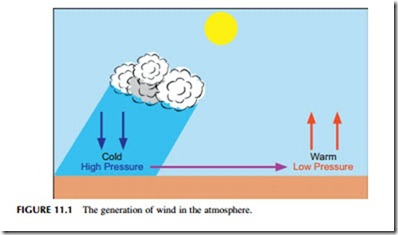WIND RESOURCES
Wind is the movement of air in response to pressure differences within the atmosphere (Figure 11.1). These pressure differences exert a force that causes air masses to move from a region of high pressure to one of low pressure. That movement is wind. The pressure differences are caused primarily by differential heating effects of the sun on Earth’s surface, although Earth’s rotation will also play a part. Thus, wind energy can be considered to be primarily another form of solar energy.
The effects that lead to the generation of winds are complex and unpredictable, and as a consequence wind is a variable and unpredictable resource. This can make wind power hard to manage on a conventional grid. Advanced
weather forecasting techniques are rendering short-term wind variations more predictable and this is helping to make the energy generated from wind easier to manage on a grid. Geographical averaging of wind capacity over a specific region can also lead to more reliable output levels, because when the wind does not blow in one part of the region it will often be blowing somewhere else. In this case the larger the region, the more predictable the resource becomes. Nevertheless, wind will always be an intermittent source of energy and this must be taken into account when installing wind capacity.
To assess whether a particular wind site is suitable for exploitation it is necessary to monitor the wind for a period of at least a year, preferably longer. Long-term average wind speeds are usually much more predictable than short-term values, so such long-term assessments provide a much more reliable means of establishing the size of the resource at a particular site.
Annually, over Earth’s land masses, around 1.7 million TWh of energy is generated in the form of wind. When oceans are included too, the figure is much higher. Even so, only a small fraction of the available wind energy can be harnessed to generate useful energy. Estimates of how large this might be are difficult; some recent estimates have suggested that global onshore wind could support generating capacities ranging from 100,000 GW to as much as 1,000,000 GW. Even the smaller of these figures is greater than the total global generating capacity from all sources of around 5000 GW. Offshore wind might provide an even greater potential than onshore wind, though exploitation of far- from-shore sites in deep waters is not possible today.
While the potential is clearly large, the exploitation of wind energy is often limited, particularly onshore, by additional restrictions that prevent construction. Urban areas are normally not considered suitable and neither are remote sites if they are close to habitations. Elsewhere, aesthetic considerations may prevent construction of wind farms. In addition, the onshore wind regime will depend critically on local geographic features that can reduce wind speeds in some areas while enhancing them in others. Another factor to take into account is the nature of the ground-cover vegetation, which will affect turbulence levels in the air layers close to Earth’s surface. As a consequence, onshore sites need to be chosen carefully and surveyed over an extended period before being developed to ensure they will provide a sufficiently rich wind regime. The best onshore wind sites are often in regions remote from urban centers. This can cause its own problems because these regions are also far from the backbone of the grid system and dedicated transmission capacity may be needed to bring the output to the users.
Offshore construction is usually less constrained than construction onshore, though it should generally avoid shipping lanes or fishing waters. The wind regime offshore is more predictable too, and the relatively smooth surface of the sea means that surface-generated turbulence is often lower than onshore while the extended open spaces allow high wind speeds to develop. Against this, turbines have to cope with regular storms at sea. Like onshore sites,
offshore wind farms may also be distant from the grid system and require lengthy transmission connections. However, there are also good offshore sites relatively close to large coastal cities, such as along the eastern seaboard of the United States, and these sites are likely to be attractive for future wind development.
An important factor for consideration at any wind site is that the wind speed increases with height above Earth’s surface. In consequence, the taller the tower upon which a wind turbine is mounted, the better the wind regime available. Large wind turbines mounted on tall towers will therefore perform better than smaller turbines on proportionally smaller towers. This wind speed gradient means that the wind speed at the lowest point of the rotor will be smaller than at the highest point. This will create a bending force on the rotor that must be taken into account in wind turbine design.
